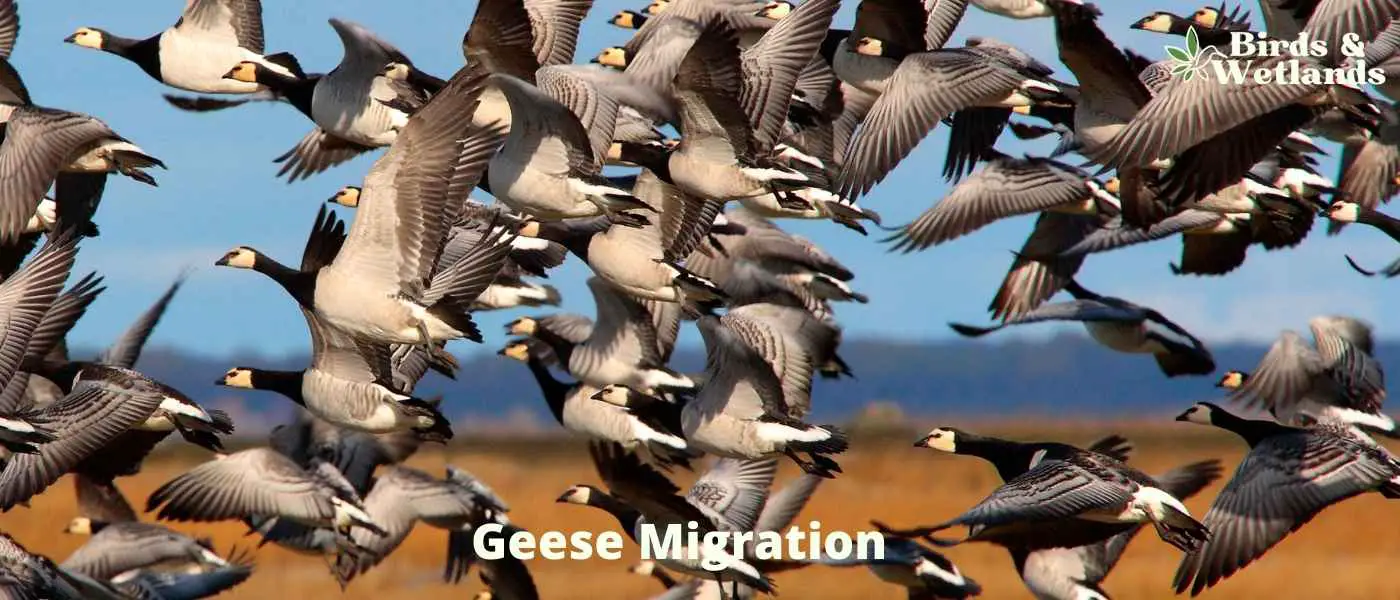Geese tend to migrate from one place to another in order to have access to better resources, therefore, following the seasons.
Whilst this has been the tradition of geese for thousands of years, the recent onset of global warnings plus more water and food resources in Northern America throughout the year, means that more and more geese are becoming resident in US states further north.
Do Canada Geese Migrate?
Migratory behavior is exhibited by many species of animals, including Canada geese. These geese migrate south in winter and north in summer, following the patterns of the changing seasons.
Some people may be surprised to learn that these birds can travel such a great distance, but their migration is a very efficient way to take advantage of the available food sources.
Following the seasons, the geese can find the best areas for feeding and nesting. Migration is a fascinating phenomenon and Canada geese are just one of the many birds that engage in this behavior.
Bird migration is a survival strategy that has evolved in response to environmental changes. It is instinctual for many bird species to migrate from temperate climates to the tropics during winter.
Birds and other animals that migrate can take advantage of seasonal resources, such as food availability and temperature.
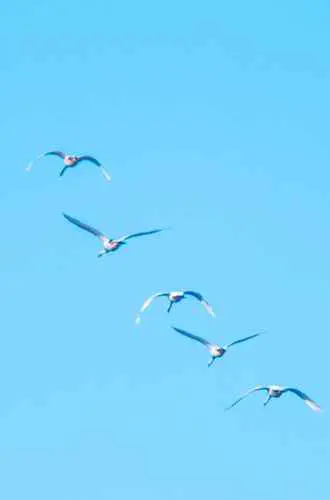
Migration can be triggered by several environmental cues, including changes in day length or temperature. For many birds, migration is a vital part of their life cycle and helps them survive and thrive.
Migrating Canada geese head south in flocks and can cover a great distance in a relatively short time. The migration of this bird species is timed to take advantage of seasonal resources, such as food availability and temperature.
Where Do Canada Geese Fly in the Winter?
Many Canada geese fly south to avoid the cold weather in Canada during the winter. They can be found in many different states in the US, including Texas, Florida, and California.
Some geese may stay in the northern states if the weather is mild, but most will eventually migrate to warmer climates.
What Are Resident Canada Geese?
There are Canadian Geese that live in the Lower 48 all year. They are called resident Canada geese. They don’t move around a lot unless it’s cold, and they can’t find food or open water.
These North American birds can be found along the Pacific coast, the Great Lakes, North Dakota and southwestern British Columbia.
Besides the milder climate, urban and suburban areas provide many geese and birds with a steady supply of food and offer a safe haven against hunters and natural predators.

Some bird enthusiasts consider resident Canadian geese to be a nuisance. Large flocks of nuisance geese often congregate in urban areas where they are not welcome, such as golf courses and parks.
This situation has created co-habitation problems between humans and geese.
Most geese can be aggressive and territorial. A male and female goose will protect their nest site, eggs and goslings from anything and anyone. Not to mention, they leave their droppings everywhere.
Although the Migratory Bird Treaty Act protects them, some states allow limited hunting of resident Canadian geese outside the traditional hunting season.
How Can You Tell Migrating Geese From Resident Ones?
One way to tell the difference between migratory and resident Canadian geese is by their behavior. Migratory Canada geese typically fly south in the fall and return to Canada in the spring to nest.
Resident Canadian geese, on the other hand, stay in the same area all year long. But apart from their behavior, it’s difficult to tell them apart.
There is no obvious physical difference between a migrating Canada goose and a resident Canada goose.
Do Black Brent Geese Migrate?
Brent geese migrate in family groups. They spend winters on the west coast of North America, from southern Alaska to California. Some brent geese also spend winters in Europe, particularly in Ireland.
The migration of brent geese is still not fully understood, but it is thought that they may use the Earth’s magnetic field to guide them on their journey.
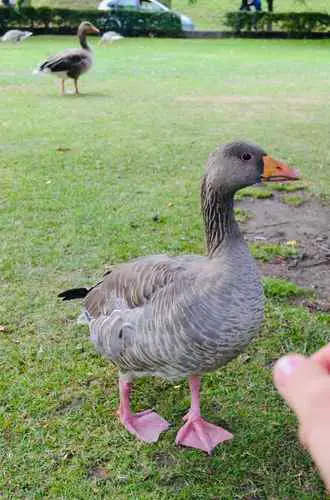
Do Snow Geese Migrate?
Snow geese migrate along the snow line in order to continue to eat along their migration route. Their diet is mostly plant-based, including seeds, roots, leaves, grasses, and berries.
By following the snow line along the Central Flyway, they are able to find food more easily and continue their journey.
Conclusion on Geese Migration
Geese migration is unpredictable, especially nowadays. Geese are interesting creatures that follow the patterns of nature in order to survive and thrive.
They migrate with the changing of the seasons, in search of better resources.
This instinctual bird behavior has been observed for centuries, but there are a lot of things we still don’t know about these wild birds.
Additional FAQs on Geese Migration
What Type of Geese Are in North America?
There are several goose species in North America. The six common species of goose that breed in North America: the Canada goose, cackling geese, black brant, snow goose, Ross’s goose, and white-fronted goose.
- Canada geese, which have seven subspecies, are among the common geese in North America with a population of about 3.6 million. It is found throughout North America, from Alaska to northern Mexico.
- The cackling goose is native to northern America. It looks a lot like a Canada goose or barnacle goose. It breeds in a variety of tundra habitats in northern Canada and Alaska. The estimated cackling goose population is around 203,700.
- Black Brent Geese have a population of about 125,000. The black brent goose population is found along the coast of northwestern Canada, Alaska, and eastern Siberia.
- The snow goose has a population of about 13 million. It is found in the arctic and subarctic regions of northern America and Russia during spring and summer.
- The Ross’s goose has a population of about 1.7 million. It breeds almost exclusively in Canada.
- The Great white-fronted goose has a population of about 700,000. It is found in northern Canada and Alaska.
How Did Climate Change Affect Migratory Geese?
Climate change has significantly impacted the migration patterns of the migratory geese population.
Earlier springs and milder winters have encouraged the geese to stay in northern areas for extended periods rather than migrate southward as they traditionally have.
This has led to overcrowding in certain areas and competition for food sources.
Additionally, the increased number of geese in northern areas has put pressure on local ecosystems.
As a result of these changes, the Canada goose migration patterns have become less predictable. The birds are now seen in parts of the country where they were once rarely spotted.
Do All Geese Fly in v Formation?
Migratory birds like geese and ducks fly in V formation to save energy during their long journey.
The lead bird in the formation breaks the wind for the rest of the birds, during the birds in the back use less energy because they follow the leader’s path.
This formation allows the flock to fly for long periods without tiring.
Not all birds migrate in V formation, however. Some birds, like the albatross, fly solo or in small groups.
Do Geese Change Migration Routes Each Year?
Geese are able to change their migratory routes, stopover sites, and wintering grounds as conditions change.
For example, if there is a lack of food in one area, they will move to another area where there is more food.
Additionally, the locations of these sites can change from year to year. This flexibility allows the geese to adapt to different conditions and helps ensure their survival.
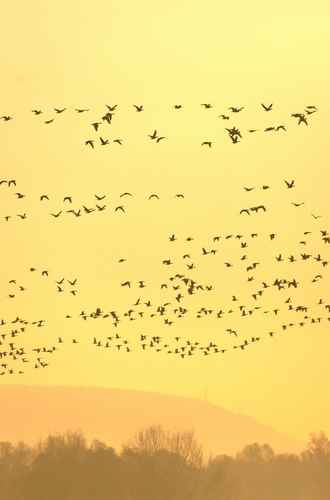
When Do Canada Goose Migration Flights Begin?
The majority of the geese in the northern hemisphere remain in their summer range until food becomes scarce and the water starts freezing.
They migrate from their nesting grounds every autumn, from September to December.
Bird migration flights usually begin at dusk, although you could see migrating geese flying in their distinctive V formation at any time of day.
Geese migrate north from their non-breeding sites to their breeding sites in April, May, or early June for the breeding season.
Some geese travel farther north including northern Alaska and the sub-Arctic region.
Are there Greylag Geese in the US?
Greylag geese can be found in the US and Canada.
They are different from the Domestic Graylag Goose, which is a flightless bird that is often seen on farms or in city parks.
Greylag geese are smaller than the Domestic Graylag Goose and are able to fly. A small flock of these geese can be found near bodies of water, such as lakes or ponds.
How Do Young Geese Learn About Migration?
Migratory birds have a unique ability to navigate their way to specific destinations during their annual migrations.
After the incubation period and once the goslings hatch, they immediately walk, swim and find their own food such as aquatic plants and other plant material with the supervision of their parents.
Young geese learn migration routes by following their parents and other adult geese. Parents fly with their young and form migratory flocks.
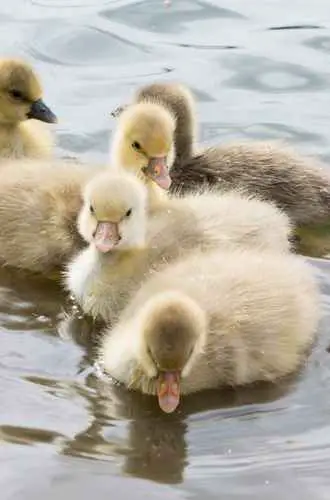
Following the lead of older, more experienced geese, the young can make the journey to their wintering grounds without getting lost.
As the weather gets colder in the fall, migratory birds begin preparing for their long journey. In the late summer, adult geese being to molt. And just before the time they migrate, they eat more food to build up their energy reserves, and they also start to grow new feathers.
The new wing feathers are essential because they help warm the birds during their long flight.
When it’s time to migrate, geese head southward. They typically travel in large groups or flocks, which makes the journey easier and safer.
The trip can be long and arduous, but eventually, the birds reach their destination.
Once there, they’ll spend the winter resting and feeding before beginning the journey back north in the spring.

